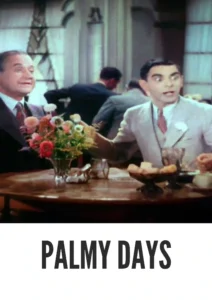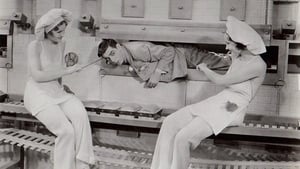Video Sources 0 Views

Synopsis
Rediscover a Classic: Download Palmy Days (1931) Colorized in HD Today!

Experience a riotous pre-Code musical comedy from Hollywood’s Golden Age with our meticulously crafted Palmy Days (1931) colorized HD download. This classic film, starring the legendary Eddie Cantor, is now available in vibrant color, offering a fresh and captivating perspective on a timeless and hilarious film. If you’re a classic film aficionado or a digital collector seeking the best quality Palmy Days (1931) colorized download, this edition is a must-own.
Movie Storyline
Palmy Days (1931) follows Eddie Simpson (Eddie Cantor), a well-meaning but somewhat hapless assistant to a phony psychic, Yolando (Charles Middleton). When Eddie leaves the fraudulent business and stumbles into a job as an efficiency expert at a family bakery that’s been transformed into a glamorous Art Deco establishment run by scantily clad Goldwyn Girls, chaos and hilarity ensue. Yolando and his henchmen attempt to eliminate Eddie, leading to outrageous situations involving giant ovens and glorifying the American doughnut.
Eddie Cantor: A Vaudeville and Broadway Legend
Palmy Days showcases the unique talents of Eddie Cantor, a major star of vaudeville, Broadway, and early film, known for his energetic performances and “banjo eyes.”
Movie Cast
- Eddie Cantor as Eddie Simpson
- Charlotte Greenwood as Helen Martin
- Barbara Weeks as Joan Clark
- Spencer Charters as Mr. Clark
- Charles Middleton as Yolando
- George Raft as Joe – Yolando’s Henchman
Movie Genre
- Musical
- Comedy
- Pre-Code
Historical Context
Released in 1931, Palmy Days reflects the zany and often bizarre humor of the Pre-Code era, with its outlandish plot, risqué costumes, and elaborate Busby Berkeley-esque musical numbers. The film offered audiences a lighthearted escape during the Great Depression.
The Goldwyn Girls
Palmy Days features the famed Goldwyn Girls, a bevy of beautiful dancers who appeared in numerous Samuel Goldwyn productions, adding glamour and spectacle to the film’s musical sequences. Betty Grable, Paulette Goddard, and Virginia Grey were among the Goldwyn Girls featured.
Colorization Details
Our colorized version of Palmy Days has been carefully produced to enhance the viewing experience while preserving the integrity of the original film. Every scene has been treated with meticulous attention to detail, bringing out the nuances of the costumes, sets, and expressions of the actors. We utilize a proprietary AI-assisted colorization process with manual correction, referencing historical data to ensure accuracy. This colorization breathes new life into the classic, making it accessible and appealing to modern audiences while honoring its historical significance.
The Art of Colorization: Bringing the Art Deco Bakery to Life
The colorization process of Palmy Days involved a dedicated team meticulously analyzing each frame, carefully selecting colors to enhance visual storytelling and evoke the unique atmosphere of the Art Deco bakery and the film’s overall zany aesthetic. We ensure our Palmy Days (1931) colorized download offers superior quality.
Technical Details
- Download Format: MP4
- Resolution: HD (1080p)
- Compatibility: Compatible with all devices
Frequently Asked Questions (FAQs)
- Q: Why download this colorized version of Palmy Days?
- A: The colorized Palmy Days offers a fresh, vibrant experience, enhancing details for modern viewers. Get the best quality Palmy Days (1931) colorized download here!
- Q: How was Palmy Days colorized?
- A: Meticulously, with historical accuracy and aesthetic detail using AI and manual correction, ensuring an authentic look.
- Q: Where can I watch Palmy Days (1931) colorized online in HD?
- A: You can download the colorized HD version of Palmy Days (1931) right here!
- Q: What is “Pre-Code” Hollywood?
- A: “Pre-Code” Hollywood refers to the era before the strict enforcement of the Motion Picture Production Code, allowing for more suggestive themes and content.
- Q: What are some of the musical highlights in Palmy Days?
- A: Enjoy Cantor’s memorable musical numbers, including “My Baby Said Yes, Yes” and “There’s Nothing Too Good For My Baby.”
Download Palmy Days (1931) colorized in HD today! Relive the magic of this timeless classic. Get your Palmy Days (1931) colorized download now!












